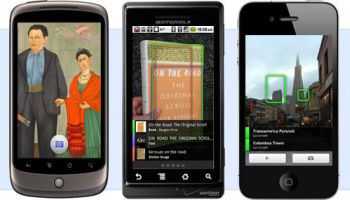

Google on 9 May added better search history and business card recognition, as well as results sharing to Google Goggles, lending some personal touches to the visual-search application.
Google Goggles allows users to snap pictures of objects with the cameras from their Android smartphone or Apple iPhone.
The application is limited in the scope of its coverage, recognising which landmarks and two-dimensional objects, such as book and CD covers, paintings and Sudoku puzzles.
Google also taught Goggles to recognise and translate menus and signs, and accelerate the speed of the application. Facial recognition via Goggles is also possible, but Google is working out the privacy issues for this feature.
In keeping with Google’s effort to socialise its company’s myriad web services, Goggles 1.4 for Android devices now lets users search their past Goggles results, add notes on those results and share them with friends. Notes will appear in a user’s search history so they can view what they wrote later.
This feature, which users can test by tapping the pencil in the corner when viewing a search result, will prove extremely useful when Google improves its product recognition for Goggles.
For example, a consumer will be able to browse clothing in a retail store, snap a picture of an item they’re interested in but not committed to buying, and write a note about what they liked and didn’t like for later reference to help in their purchase decision.
The user can then check their search history for words in their note to help find out more about the product.
Goggles now boasts better business card recognition, which lets users snap a picture of a person’s business card to have Google retrieve results about the card owner.
Now, instead of recognising a business card content purely as text, the application recognises the information as a contact to call immediately or add to a user’s Android phone’s contact list.
Finally, Goggles 1.4, available now for Android 1.6 and later handsets, lets users suggest a better result when Goggles cannot find an image match.
To access this feature, users will tap the “Can you suggest a better result?” prompt on the results page and then select the relevant part of the image and submit a tag.
These tags will be used to improve recognition in object categories where Goggles already provides some results.
One day, Goggles will likely be used as an augmented-reality vector in some instances, though Google has yet to work out how that will work, Shailesh Nalawadi, Goggles product manager, told eWEEK.
AI is transforming cybersecurity, offering faster defence and smarter attacks. Learn how businesses can harness…
Search engine giant being sued for £5 billion ($6.64 billion) damages over allegations for online…
H20 chip designed for Chinese market now requires special export licence, as Trump Administration tightens…
Apple reportedly working on lighter, cheaper Vision Pro, another model that links directly to Mac…
OpenAI says GPT-4.1 model family can understand prompts with up to 1 million tokens, features…
Blue Origin jaunt sends Jeff Bezos fiancée Lauren Sanchez into space along with Katy Perry…